IT'S TIME TO HONOR MIKE BATES
"A RARE AMERICAN SOLDIER"
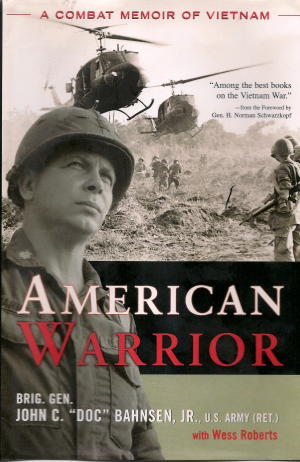
Author says "Bates knew no fear ...
excelled with unique leadership role"
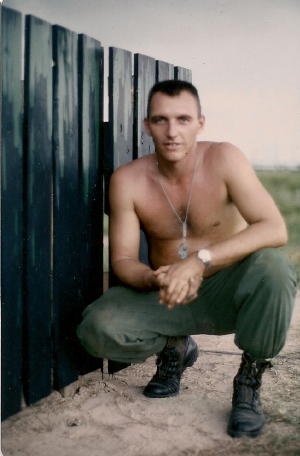
Bates' life was like a Hollywood movie
By Bob Weaver 2010
Mike Bates' life is like a Hollywood movie, from his well-documented military history in Vietnam, flying a chopper in Alaska, downing a chopper near the Arctic Circle, to his early entry into the computer world.
The 66-year-old Bates from Calhoun County, died in Watauga, Texas in February, 2010, after a long battle with cancer.
His smartness and steel-grit courage made him a stand-out soldier during the Vietnam War, a troubling time in American history.
Perhaps, his untold story is how five years of combat in Vietnam changed his life, flying a chopper and being a combat pilot.
It is a moving experience to look at photos shot by Bates, and photos of the death, pain and destruction of the Vietnam War, rarely seen in America's homogenized "bloodless" conflicts of the 21st century, apparently toned-down by the government and national media.
Brigadier General John C. "Doc" Bahnsen, Jr., retired US Army and
author of "American Warrior," wrote about Bates in his book, and this tribute on the Herald following his death.
Gen. H. Norman Schwarzkopf said Bahnsen's book was "Among the best books about the Vietnam War."
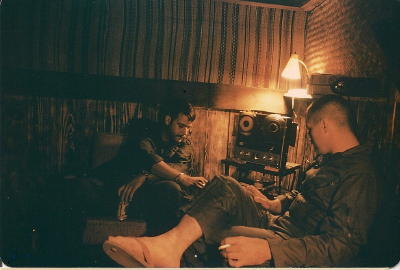
Bates (left) waiting with his buddy for the next mission
Longtime friend Larry McCallister called him a "free spirit," a phrase his wife has decided to place on his military marker.
"He was one of the smartest people I've ever known, a man who always followed his dreams. He received seven Distinguished Flying Crosses for his service as a helicopter pilot in Vietnam," McCallister said.
He was a member of the Mensa Society, the largest and oldest high-IQ society in the world, open to people who score at the 98th percentile or higher on standardized intelligence tests.
Mike was a computer software developer, starting early in the computer world. He developed and sold software beginning with Tandy in the 1970's and then with IBM PC's in the 1980's.
Obituary: Michael Don Bates
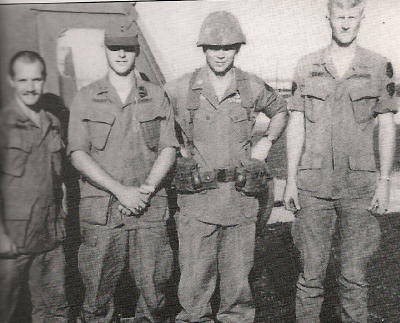
Bates (2nd from left) with his flight crew in 1968 (Rex Saul)
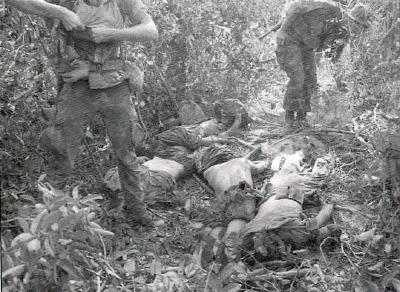
Bates' outfit searching enemy dead after firefight in jungle (Rex Saul)
TRIBUTE TO AN AMERICAN WARRIOR
"He Fought Virtually Every Day"
By Brigadier General John C. "Doc" Bahnsen, Jr.
Retired US Army ~ Author of "American Warrior"
During my two tours of duty in Vietnam I had the good fortune to command some extraordinarily talented, courageous and honorable soldiers. Their rank, age, religion, education and training, and backgrounds varied but they shared one very important trait: they were soldiers who exemplified the motto Duty, Honor, Country during a tumultuous time in our nation's history.
A divisive, bitter battle over Civil Rights concurrent with oft riotous opposition to the Vietnam War ripped at the fabric our nation.
Ironically it was also a time when many of the best of America's young joined veteran soldiers in a divisive, bitter battle in Southeast Asia where North Vietnamese communist forces were ripping at the fragile fabric of democratic rule in South Vietnam.
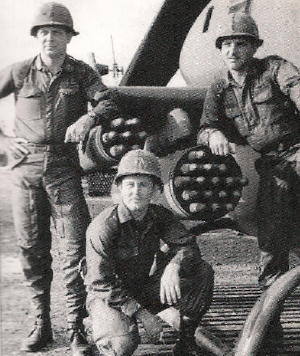
(L to R) Brig. General "Doc" Bahnsen, Jr. (Author)
Second Lts. Guy Ballou and Mike Bates, who "knew no fear"
A patriot in thought and action, I have no equivocation in testifying that Mike Bates was prominent among the best of America's young just as he was among the best of the soldiers I had the good fortune to command in the war effort to defend the freedom of people in a far away land, a people who had no hope of remaining free on their own.
I first met then-Warrant Officer One Mike Bates at Alpha Pad on Bien Hoa Air Base in South Vietnam in September of 1968, a few days after I arrived in-country for my second tour.
I was on orders to assume command of the Air Cavalry Troop, 11th Armored Cavalry Regiment â the "Blackhorse" then under the command of my long time mentor Colonel George S. Patton, son of the legendary World War Two general.
A native West Virginian, Mike was articulate, bright and ambitious even as a young man. A world of promising possibilities awaiting him.
Mike, like all young men in those days, had a military obligation to fulfill before he ventured to seek his chosen career. The idea of flying helicopters held a certain fascination for Mike, enough so that he opted to join the Army after a recruiter guaranteed him the opportunity to attend rotary wing flight school.
Mike was selected as the Warrant Officer Candidate Battalion Commander during his flight school. That special recognition was not granted frivolously, but because of his readily recognizable leadership aptitude.
He was the kind of guy who looked and acted like someone you would want to follow. Mike excelled that unique leadership role and went on to graduate at the top of his class.
Those accomplishments earned him orders to attend AH-1 Cobra attack helicopter transition training directly out of basic flight school. That rarely granted distinction authenticated his high potential as both a leader among men and certified him as a remarkably skillful pilot.
Mike arrived at the Air Cavalry Troop shortly before I did. His positive can-do attitude and proficient piloting skills had been fittingly recognized and Mike quickly became the designated pilot for the troop commander.
Patton personally selected me to command the Air Cavalry Troop. Everyone in the troop knew that in advance of my arrival. There were also rumors about Patton wanting sweeping changes in how the troop operation, and I was chosen to be his broom. Rumors can be nothing more than malicious falsehoods. But on that occasion they were spot-on.
During the change of command ceremony, I introduced myself to the troop by informing one and all that we would no longer operate as a gunship company for the regiment, that we would start operating as an air cavalry troop, that our mission was to find, fix, and kill or capture as many enemy soldiers as we could.
As I expected it would be, my assumption of command was met by a mixture of curiosity, suspicion and some stubborn resistance.
To effect the troop's change in direction required the support of my subordinate leaders. That was not a fail-safe assumption. Neither was the loyal support of my troopers. Both groups needed to trust me first. And trust among soldiers is earned, not given away.
Although I took a liking to him right away, Mike and I spent a few days sizing one another up. We had our individual differences but we were alike in that we shared a penchant for being strong-headed, determined, motivated, and self-confidentâsome of the traits key to leading in combat.
I was immediately impressed by Mike's military bearing, his respectful manner, his boundless energy and his easy going sense of humor.
Reshaping the troop from a gunship company into what others have said was the most effective air cavalry troop, if not small fighting force, in Vietnam at the time was not without challenges and obstacles.
To that end, Mike's disarmingly candid counsel on how I might best win the troopers over, earn their trust, and gain their unfailing loyalty proved invaluable to me.
For the next eight months, Mike and I flew combat missions together.
We were a fierce-fighting team.
We anticipated one another in the heat of battle. I am positive that regularly spared our lives and those of our troopers as well as that of friendly forces. We encouraged one another when only encouragement could energize our tired bodies to fight on for just a little longer.
We laughed together, finding humor in things that we might not have paid thought to in other circumstances. We mourned together every time one of troop's soldiers was killed or wounded in action.
By the grace of God, those killed comprised a short list. Only ten soldiers died under my command of the Air Cavalry Troop. While one killed is one too many, ten soldiers killed is an exceptionally low number when factored with an extraordinarily the exceptionally high number of enemy contacts the troop engaged in.
We fought virtually every day. And Mike and I celebrated together after returning from numerous missions with our helicopter riddled by enemy small-arms and automatic weapons fire.
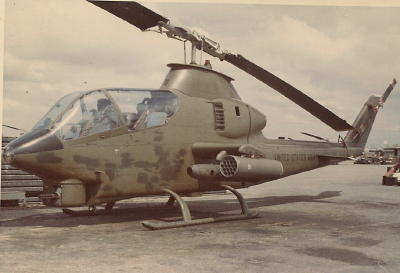
Bates flew hundreds of missions, flying virtually every day
In total, we logged several hundred hours flying side by side in one or the other of our two command UH-1 helicoptersâ known as Hueys, the workhorse utility helicopter that became the most recognizable symbol of the Vietnam War.
It was not unusual for us to log twelve hours of flying time in a single day. An aggregate of 140 flying hours a month was an average one for Mike.
There were occasions when either our door gunner or crew chief was wounded, yet Mike and I returned to Alpha Pad with nothing more than a few scraps, scratches and bruises.
In fact, the only time I was wounded seriously enough to seek medical attention was during a combat assault when Mike was not flying with me.
Our loyal crew chief, Mike Gorman, was shot through the neck while sitting behind us during a major enemy contact in January of 1969. We landed in the jungle where Mike administered first aid to Gorman, saving his life.
Gorman has been paralyzed from the waist down since that date and lives by himself up in Vermont. To this day, Gorman credits Mike Bates with keeping him alive and holds him in the very highest regard.
When I informed him of Mike's passing, we cried together.
I can truthfully say that Mike never displayed any fear when being shot at, in fact quite the opposite. He wanted to go after the people who shot at us and did that at every opportunity.
He was imbued with the confidence found in very few soldiers who know they can best any enemy on any battlefield. His aggressiveness was contagious and inspired everyone who saw him in action.
Over the time he served with me, Mike learned to make decisions and pass orders to other senior leaders when I was on the ground.
Colonel Patton knew Mike personally and had the highest regard for his fighting ability. The troop's enlisted soldiers thought the world of Mike.
His fellow officers looked up to him and sought his counsel. Everyone who knew Mike liked him and respected his soldierly qualities.
The stories about Mike's heroics in combat are found in my memoirs, American Warrior, only in part. Mike and I could have died many times during our days in Vietnam. We both lived to see our children grow up and to know our grandchildren. We lived a charmed life, deserved or not, we were lucky.
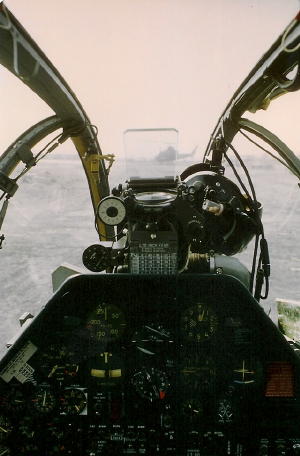
Mike spent his Vietnam years looking through this cockpit window
Although medals alone cannot speak to a soldier's courage under fire, Mike accumulated an impressive set of them.
For his extraordinary valor Mike was awarded a Silver Star, seven Distinguished Flying Crosses, three Bronze Stars, over thirty Air Medals, and three Purple Hearts, and numerous other awards for meritorious service in a combat zone.
Patton and I recognized Mike's leadership and war-fighting skills in yet another way. We petitioned the Department of the Army to grant him a direct commission to second lieutenant.
Patton's endorsement of that petition read in part, "Mr. Bates is one of the best fighting soldiers in the 11th Armored Cavalry Regiment where bravery under fire is the norm. He should be commissioned immediately for the good of the service."
It was a great day when I pinned a gold bar on the collar of his fatigues.
Mike Bates was one of those rare American soldiers who are natural leaders, who inspire confidence and resolve in others. He was invaluable on the battlefield and a friend to all who knew him. Had he stayed in the service I am certain that he would have risen to high rank.
I will miss Mike greatly. He was like a younger brother to me. We meshed in temperament and in a lot of our thinking. Farewell my old friend, I will see you again on the other side. -
Doc Bahnsen
Thunderhorse Six
6 February 2010
Photos from "American Warrior"
and from Mike Bates' personal scrapbook
| 


